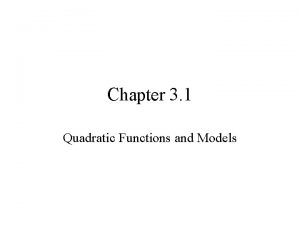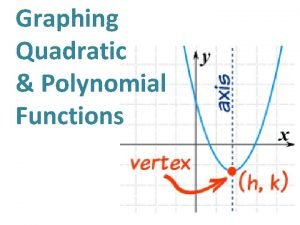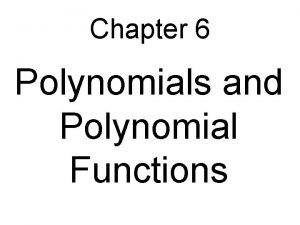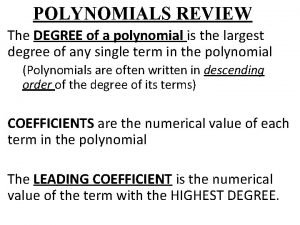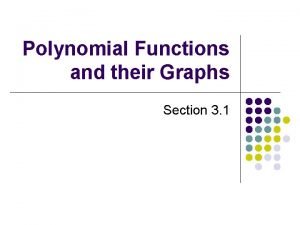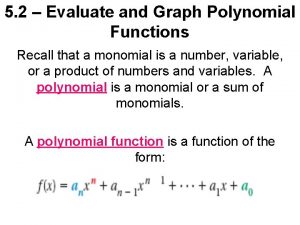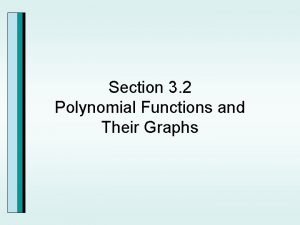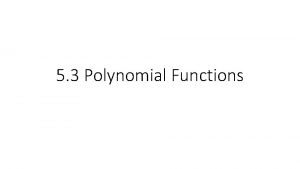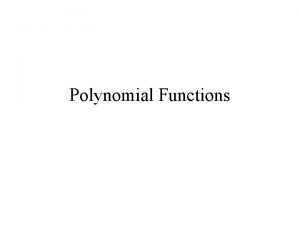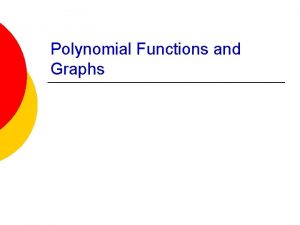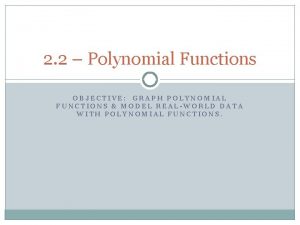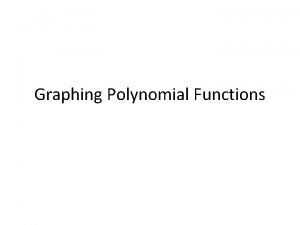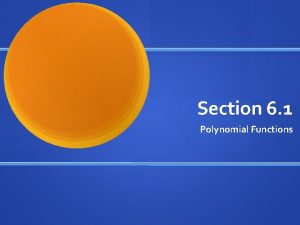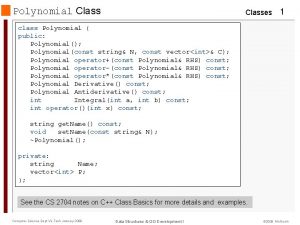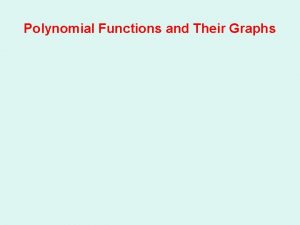3 3 Polynomial Functions and Models A polynomial

















- Slides: 17

3. 3 Polynomial Functions and Models

A polynomial function is a function of the form

Determine which of the following are polynomials. For those that are, state the degree. (a) Polynomial. Degree 2. (b) (c) Not a polynomial.

If f is a polynomial function and r is a real number for which f(r)=0, then r is called a (real) zero of f, or root of f. If r is a (real) zero of f, then (a) r is an x-intercept of the graph of f. (b) (x - r) is a factor of f.

Use the above to conclude that x = -1 and x = 4 are the real roots (zeroes) of f.

1 is a zero of multiplicity 2. -3 is a zero of multiplicity 1. -5 is a zero of multiplicity 5.

If r is a Zero or Even Multiplicity If r is a Zero or Odd Multiplicity .

Theorem If f is a polynomial function of degree n, then f has at most n-1 turning points.

Theorem For large values of x, either positive or negative, the graph of the polynomial resembles the graph of the power function.

For the polynomial (a) Find the x- and y-intercepts of the graph of f. (b) Determine whether the graph crosses or touches the x-axis at each x-intercept. (c) Find the power function that the graph of f resembles for large values of x. (d) Determine the maximum number of turning points on the graph of f.

For the polynomial (e) Use the x-intercepts and test numbers to find the intervals on which the graph of f is above the x-axis and the intervals on which the graph is below the x-axis. (f) Put all the information together, and connect the points with a smooth, continuous curve to obtain the graph of f.

(a) The x-intercepts are -4, -1, and 5. y-intercept: (b) -4 is a zero of multiplicity 1. (crosses) -1 is a zero of multiplicity 2. (touches) 5 is a zero of multiplicity 1. (crosses) (d) At most 3 turning points.

Test number: f (-5) Graph of f: -5 160 Above x-axis Point on graph: (-5, 160)

-4 < x <-1 Test number: -2 f (-2) -14 Graph of f: Below x-axis Point on graph: (-2, -14)

-1 < x < 5 Test number: f (0) Graph of f: 0 -20 Below x-axis Point on graph: (0, -20)

Test number: f (6) Graph of f: 6 490 Above x-axis Point on graph: (6, 490)

(6, 490) (-5, 160) (-4, 0) (-2, -14) (-1, 0) (0, -20) (5, 0)
 What is the difference between semi modals and modals?
What is the difference between semi modals and modals? Curve fitting with polynomial models
Curve fitting with polynomial models Using recursion in models and decision making sheet 3
Using recursion in models and decision making sheet 3 Quadratic functions and models
Quadratic functions and models Chapter 1 graphs functions and models answers
Chapter 1 graphs functions and models answers Numpy.polynomial.polynomial
Numpy.polynomial.polynomial How to divide a polynomial by another polynomial
How to divide a polynomial by another polynomial Polynomial standard form
Polynomial standard form Chapter 4 polynomial and rational functions
Chapter 4 polynomial and rational functions Chapter 3 polynomial and rational functions
Chapter 3 polynomial and rational functions Chapter 6 polynomials and polynomial functions
Chapter 6 polynomials and polynomial functions Degree 5 graph
Degree 5 graph Number of terms example
Number of terms example Evaluate and graph polynomial functions
Evaluate and graph polynomial functions Polynomial functions and their graphs
Polynomial functions and their graphs Polynomial functions and their graphs
Polynomial functions and their graphs Chapter 3 polynomial and rational functions
Chapter 3 polynomial and rational functions Real world phenomena
Real world phenomena



